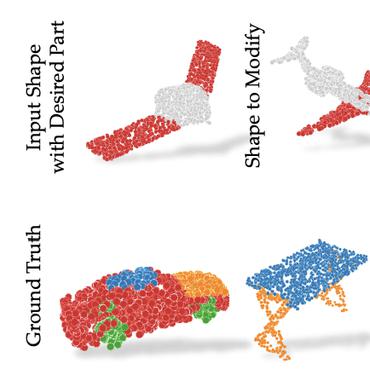Search Results for author: Dinesh Bharadia
Found 15 papers, 3 papers with code
S³Net: Semantic-Aware Self-supervised Depth Estimation with Monocular Videos and Synthetic Data
no code implementations • ECCV 2020 • Bin Cheng, Inderjot Singh Saggu, Raunak Shah, Gaurav Bansal, Dinesh Bharadia
In order to learn such a scalable depth estimation model, we require a ton of data and labels which are targeted towards specific use-cases.
mmFlexible: Flexible Directional Frequency Multiplexing for Multi-user mmWave Networks
no code implementations • 26 Jan 2023 • Ish Kumar Jain, Rohith Reddy Vennam, Raghav Subbaraman, Dinesh Bharadia
Modern mmWave systems have limited scalability due to inflexibility in performing frequency multiplexing.
GreenMO: Virtualized User-proportionate MIMO
no code implementations • 29 Nov 2022 • Agrim Gupta, Sajjad Nassirpour, Manideep Dunna, Eamon Patamasing, Alireza Vahid, Dinesh Bharadia
The reason is that traditionally MIMO requires a separate RF chain per antenna, so the power consumption scales with number of antennas, instead of number of users, hence becomes energy inefficient.
Spoofing Attack Detection in the Physical Layer with Commutative Neural Networks
1 code implementation • 8 Nov 2022 • Daniel Romero, Peter Gerstoft, Hadi Givehchian, Dinesh Bharadia
In a spoofing attack, an attacker impersonates a legitimate user to access or tamper with data intended for or produced by the legitimate user.
Deep Learning Object Detection Approaches to Signal Identification
no code implementations • 27 Oct 2022 • Luke Wood, Kevin Anderson, Peter Gerstoft, Richard Bell, Raghab Subbaraman, Dinesh Bharadia
Traditionally source identification is solved using threshold based energy detection algorithms.
R-fiducial: Reliable and Scalable Radar Fiducials for Smart mmwave Sensing
no code implementations • 27 Sep 2022 • Kshitiz Bansal, Manideep Dunna, Sanjeev Anthia Ganesh, Eamon Patamsing, Dinesh Bharadia
Millimeter wave sensing has recently attracted a lot of attention given its environmental robust nature.
RadSegNet: A Reliable Approach to Radar Camera Fusion
no code implementations • 8 Aug 2022 • Kshitiz Bansal, Keshav Rungta, Dinesh Bharadia
Contrary to these approaches, we propose a new method, RadSegNet, that uses a new design philosophy of independent information extraction and truly achieves reliability in all conditions, including occlusions and adverse weather.
Pointillism: Accurate 3D bounding box estimation with multi-radars
no code implementations • 8 Mar 2022 • Kshitiz Bansal, Keshav Rungta, Siyuan Zhu, Dinesh Bharadia
We introduce a novel concept of Cross Potential Point Clouds, which uses the spatial diversity induced by multiple radars and solves the problem of noise and sparsity in radar point clouds.
BeamScatter: Scalable, Deployable Long-Range backscatter communication with Beam-Steering
no code implementations • 27 Oct 2021 • Manideep Dunna, Shihkai Kuo, Akshit Agarwal, Patrick Mercier, Dinesh Bharadia
WiFi backscatter tags can enable direct connectivity of IoT devices with commodity WiFi hardware at low power.
Two beams are better than one: Enabling reliable and high throughput mmWave links
1 code implementation • 12 Jan 2021 • Ish Kumar Jain, Raghav Subbaraman, Dinesh Bharadia
Multi-beam links are reliable since they are resilient to occasional blockages of few constituent beams compared to a single-beam system.
WiForce: Wireless Sensing and Localization of Contact Forces on a Space Continuum
no code implementations • 31 Dec 2020 • Agrim Gupta, Cedric Girerd, Manideep Dunna, Qiming Zhang, Raghav Subbaraman, Tania Morimoto, Dinesh Bharadia
Contact force is a natural way for humans to interact with the physical world around us.
Sampling Training Data for Continual Learning Between Robots and the Cloud
no code implementations • 12 Dec 2020 • Sandeep Chinchali, Evgenya Pergament, Manabu Nakanoya, Eyal Cidon, Edward Zhang, Dinesh Bharadia, Marco Pavone, Sachin Katti
Today's robotic fleets are increasingly measuring high-volume video and LIDAR sensory streams, which can be mined for valuable training data, such as rare scenes of road construction sites, to steadily improve robotic perception models.
SSLIDE: Sound Source Localization for Indoors based on Deep Learning
no code implementations • 27 Oct 2020 • Yifan Wu, Roshan Ayyalasomayajula, Michael J. Bianco, Dinesh Bharadia, Peter Gerstoft
This paper presents SSLIDE, Sound Source Localization for Indoors using DEep learning, which applies deep neural networks (DNNs) with encoder-decoder structure to localize sound sources with random positions in a continuous space.
$S^3$Net: Semantic-Aware Self-supervised Depth Estimation with Monocular Videos and Synthetic Data
no code implementations • 28 Jul 2020 • Bin Cheng, Inderjot Singh Saggu, Raunak Shah, Gaurav Bansal, Dinesh Bharadia
We present $S^3$Net, a self-supervised framework which combines these complementary features: we use synthetic and real-world images for training while exploiting geometric, temporal, as well as semantic constraints.
SIGNet: Semantic Instance Aided Unsupervised 3D Geometry Perception
2 code implementations • CVPR 2019 • Yue Meng, Yongxi Lu, Aman Raj, Samuel Sunarjo, Rui Guo, Tara Javidi, Gaurav Bansal, Dinesh Bharadia
SIGNet is shown to improve upon the state-of-the-art unsupervised learning for depth prediction by 30% (in squared relative error).
 Ranked #62 on
Monocular Depth Estimation
on KITTI Eigen split
Ranked #62 on
Monocular Depth Estimation
on KITTI Eigen split




